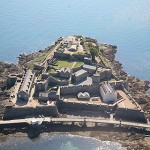 Castle Cornet has been at the centre of the Island’s history for almost 800 years. It was probably named after a family called de Cornet who held land in the area and has been extended and adapted over the centuries. In 1642 the Castle found itself not guarding the harbour and the town, but attacking it. When the English Civil War broke out the Island declared for Parliament. This was largely as a result of Sir Thomas Leighton’s Puritan stewardship. An efficient but austere man, he was widely disliked by the local people.
Castle Cornet has been at the centre of the Island’s history for almost 800 years. It was probably named after a family called de Cornet who held land in the area and has been extended and adapted over the centuries. In 1642 the Castle found itself not guarding the harbour and the town, but attacking it. When the English Civil War broke out the Island declared for Parliament. This was largely as a result of Sir Thomas Leighton’s Puritan stewardship. An efficient but austere man, he was widely disliked by the local people.
After three eminent Guernsey men who had been tricked into going to the Castle managed to escape the die was cast. The Castle and the Island were at war. Sir Peter Osborne and his successors held the Castle for nearly nine years with only minimal help from Royalist Jersey and it was the last stronghold in Britain to surrender. Castle Cornet’s role in the saga continued after the restoration of Charles II when one of Cromwell’s most eminent deputies, General John Lambert, was imprisoned here. In 1672 an explosion ripped out the heart of Castle Cornet destroying the medieval buildings, the keep and members of the Governor’s family. It was never again used a residence though its role as guardian of St Peter Port harbour continued until the 20th century.
In 1681 The Privilege of Neutrality was brought to an end and the age of Privateering began. There were almost continuous wars between the British and the French as they attempted to expand their empires world – wide. The Government, in part to free up Royal Navy ships, allowed ships’ captains to apply for a ‘Letter of Marque’ so that they could seize enemy ships without being branded as pirates. So successful were the families involved that it almost became an island industry. It was estimated that Islanders made millions of pounds from the capture of French and American ships. An offshoot of Privateering was an increase in smuggling or ‘Free Trade’ as the islanders called it. Guernsey was in an ideal position between France and England and the quantities of wine and brandy stored in local vaults spawned a secondary industry for cask making. The islanders resisted all attempts to set up a customs house and those involved became the ‘nouveau riches’ whose Georgian Town houses can be seen around St Peter Port’s boundaries. By this time over half of Guernsey’s population lived in St Peter Port. A subscription was raised for the Town Hospital to be built as a refuge and support for the poor but this had more to do with Christian concern than the financial rewards from Privateering. Records show that a number of wives abandoned by the soldiers garrisoned in Castle Cornet as they moved on, had reason to be grateful for this institution.
There was still a vast difference between those who lived in ‘Town’ and those who lived in the country parishes. Country people still spoke Norman – French and were largely involved in agriculture and fishing. They ventured into town to go to the weekly market but country roads were appalling. A Militiaman based at Chateau du Rocquaine had no road to take him along the coast to the Vale Parade ground. Instead he had to make an arduous journey into town and out again.